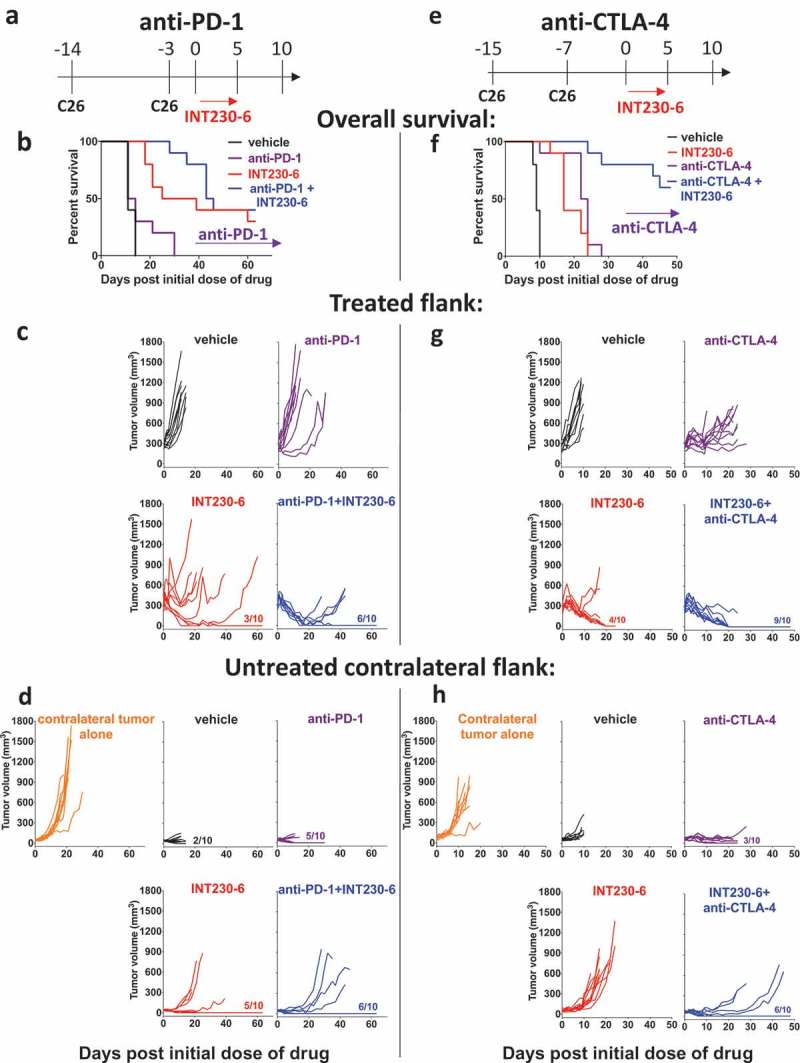Figure 5.

Contralateral tumor response can be induced by INT230-6 in combination with anti-CTLA-4 but not with anti-PD-1.
a) Illustration of INT230-6 and anti-PD-1 treatment regimen (top). C26 (1x106) were inoculated into the right flank (day −14). Contralateral tumors were inoculated 11 days after primary tumors (day −3). Primary tumors were treated with INT230-6 (50 μl/400 mm3 tumor, 5 sequential days) starting on day 0. Average primary tumor volume on day 0 was 290mm3 and average contralateral tumor volume was 42mm3. Anti-PD-1 treatment (100 μg) was given on day 0, 3, 7 and 10. b) Kaplan-Meier plot (below illustration) and individual responses of c) treated (ipsilateral) (middle) and d) contralateral flank (bottom) are shown of vehicle (black), anti-PD-1 (purple), INT230-6 (red) and anti-PD-1+ INT230-6 (blue) treatment as well as contralateral tumor only control (orange, n = 10/group). Fractions (e.g. 3/10) indicate the number of mice that completely lost tumor that the indicated flank. Log-rank test was significantly different between vehicle and INT230-6 (p < 0.0001), vehicle and anti-PD-1+ INT230-6 (p < 0.0001), anti-PD-1 and INT230-6 (p < 0.01) and anti-PD-1 and anti-PD-1 + INT230-6 (p < 0.0001). Two-way ANOVA with Sidak’s multiple comparison test of growth curves showed that untreated contralateral tumors only were significantly different (p < 0.0001) from all groups on secondary site. Furthermore, vehicle was significantly different (p < 0.0001) from INT230-6 and INT230-6+ anti-PD-1 on day 8 and 11 on the primary site. Vehicle was significantly different (p < 0.05) from INT230-6+ anti-PD-1 on day 11 on the secondary site. INT230-6 was significantly different anti-PD-1 or INT230-6+ anti-PD-1 on day 16 (p < 0.01) and day 18 (p < 0.001) on the primary tumor site. INT230-6 was significantly different (p < 0.01) from INT230-6 + anti-PD-1 on day 18 on the contralateral site. Anti-PD-1 was significantly different (p < 0.0001) from INT230-6+ anti-PD-1 on day 8 and 11 at the primary site only. e) Illustration of INT230-6 and anti-CTLA-4 treatment regimen (top). C26 (1x106) tumor cells were inoculated into the right flank (day −15). Contralateral tumors were inoculated 7 days after primary tumors (day −8). Primary tumors were treated with INT230-6 (50 μl/400 mm3 tumor, 5 sequential days) starting on day 0. Average primary tumor volume on day 0 was 250mm3 and average contralateral tumor volume was 60mm3. Anti-CTLA-4 treatment (100 μg) was given on day 0, 3 and 6. f) Kaplan-Meier plot (below illustration) and individual responses of g) treated (ipsilateral) (middle) and h) contralateral flank (bottom) are shown of vehicle (black), anti-CTLA-4 (purple), INT230-6 (red) and anti-CTLA-4+ INT230-6 (blue) treatment as well as contralateral tumor only control (orange, n = 10/group). Fractions (e.g. 4/10) indicate the number of mice that completely lost tumor in the indicated flank. Log-rank test was significantly different between vehicle and all other groups (p < 0.0001), INT230-6 and anti-CTLA-4+ INT230-6 (p < 0.0001) and anti-CTLA-4 and anti-CTLA-4+ INT230-6 (p < 0.0001). All experiments were performed twice. Two-way ANOVA with Sidak’s multiple comparison test of growth curves showed that untreated contra-later tumors were significantly different (p < 0.0001) from all other groups on the contralateral site. Vehicle was significantly different (p < 0.0001) from INT230-6, anti-CTLA-4 and anti-CTLA-4+ INT230-6 on day 6 and 8 at the primary (ipsilateral) site. Vehicle was significantly different from anti-CTLA-4 (day 8: p < 0.0001) and anti-CTLA-4+ INT230-6 (day 6: p < 0.001, day 8: p < 0.0001) at the contralateral site. INT230-6 was significantly different from anti-CTLA-4 at the primary site (day 8: p < 0.05, day 10: 0.001) and secondary site (day 8: p < 0.01, day 9: p < 0.001, day 10: p < 0.0001). INT230-6 was significantly different from anti-CTLA-4 + INT230-6 at the contralateral site only (day 6: p < 0.05, day 8–10: p < 0.0001). Anti-CTLA-4 was significantly different from anti-CTLA-4 + INT230-6 at the primary site (day 8: p < 0.01, day 9: p < 0.05, day 10: p < 0.0001) and at the secondary site (day 6: p < 0.05).
